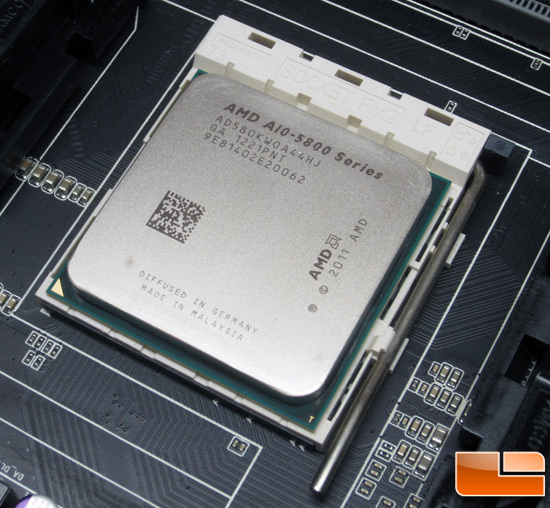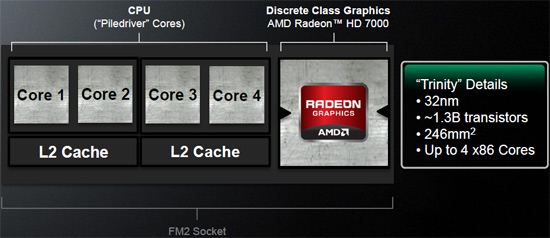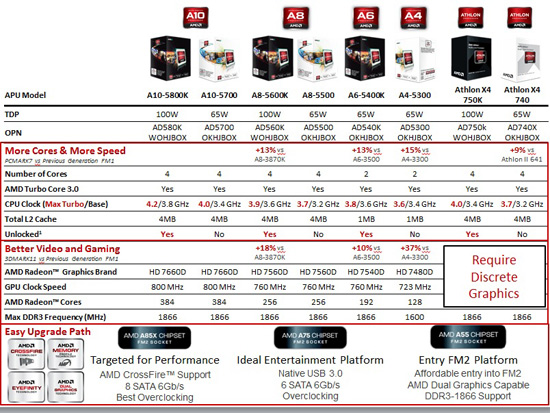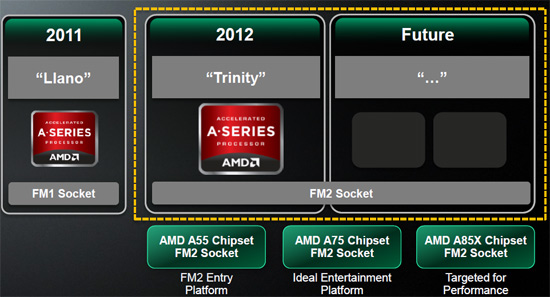AMD A10-5800K Trinity Desktop APU Review
AMD A10-5800K Trinity APU

Last week AMD gave us the go ahead to show off their latest APU (Accelerated Processong Unit) which combines the AMD ‘Trinity’ Core with discrete level graphics. The preview of the new Trinity desktop APU was limited to gaming benchmarks as well as a much more subjective user experience. Overall the results of the preview were very promising and Trinity was able to dominate the gaming benchmarks that we ran. Last week we were also unable to discuss the retail price of the new AMD A10-5800K. Now that the launch is upon us, every thing is fair game!

The AMD A-Series desktop APU’s are at great price point. The highest retail price APU is the AMD A10-5800K that we have on our bench today and it has a suggest retail price of $122! A quick look online shows that this processor has a street price of $143 shipped. The A4-5300 is the lowest cost A-Series APU and retails for only $53.00. With four other AMD FM2 APU’s coming out today between those price points, there is sure to be one right for you. Last week we saw the AMD A10-5800K bringing the Intel Core i7 3770K to it’s knees when comparing the on board graphics. The Intel Core i7 3770K is currently retailing for $324.98, so for a little more than a third of the price you can have the A10-5800K that crushes the competition when using the onboard graphics.

AMDs new ‘Trinity’ APU are still manufactured by GlobalFoundries’ on the 32 nm SOI process process, but is based on the newer Piledriver x86 architecture. This is the same architecture that is used on high-end Bulldozer processors, so we finally see this technology becoming available in more affordable processors. The Trinity APU has roughly 1.3 billion transistors and is 246mm2.
AMD also improved the graphics architecture in Trinity and rather than using the VLIW5 arrangement found in Llano, AMD went when the VLIW4 design. AMD used VLIW5 in Radeon HD 6800 and older GPUs and used VLIW4 in the Radeon HD 6900 series cards. All of the newer Radeon HD 7000 series cards use Graphics Core Next (GCN) designs, so expect to see VLIW4 being short lived in APUs as well.

The AMD A10-5800K will be AMDs flagship processor and that will be the one we will be using today for testing. This processor has a 3.8Ghz base clock and can go up to 4.2GHz thanks to AMD TurboCore 3.0 technology. Don’t expect it to be at 4.2GHz for long though as it has many intermediate P-states and is bouncing all over the place for power savings. The AMD A10-5800K also has 4MB of L2 cache and is a ‘K’ part, which means it is unlocked for easier overclocking. On the graphics side of things, it has the AMD Radeon HD 7660D GPU with 384 cores running up to 800MHz.
New AMD Desktop Processors:
- AMD A10-5800K w/ AMD Radeon HD 7660D Graphics
- AMD A10-5700 w/ AMD Radeon HD 7660D Graphics
- AMD A8-5600K w/ AMD Radeon HD 7560D Graphics
- AMD A8-5500 w/AMD Radeon HD 7560D Graphics
- AMD A6-5400k w/ AMD Radeon HD 7540D Graphics
- AMD A6-5300 w/ AMD Radeon HD 7480D Graphics
- AMD Athlon X4 750K
- AMD Athlon X4 740

The one bad thing about the new APUs is that they can only be used on motherboards with the new FM2 processor Socket. AMD had to change the pin count from Llano to Trinity and that royally screws all the early APU adopters. AMD didn’t originally expect this change and understands that it is a bad situation. The AMD A75 chipset is compatible with the new Trinity APU’s, so you will see ‘new’ AMD A75 based boards coming out alongside the new AMD A85 chipset. The AMD A85 chipset adds two more SATA III 6Gbps ports, improved overclocking features and enhanced AMD CrossFireX support. AMD said that the next generation APU will work with FM2 sockets, so if you buy a board for Trinity then you’ll have an upgrade path next year.

Comments are closed.